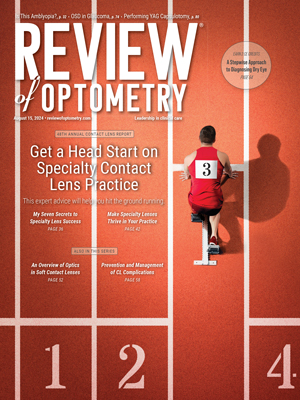 |
Opponents of optometric scope expansion rely on fear-mongering arguments that claim, without evidence, that patient safety would be at risk if ODs were given the legal right to perform minor laser procedures like SLT and YAG capsulotomy. You can see why they employ that tactic: it gives them the moral high ground. Who would dare to be against public safety? Of course, baked into that argument is the supposition—you could go ahead and call it a bias or prejudice if you want—that optometrists are inherently unfit for these responsibilities, a premise that has no basis in reality.
We’ve extensively covered the legislative battles on scope expansion for years, and inevitably the argument comes down to optometric training and what opponents see as inadequacies there. Mind you, they almost never cite any outcomes statistics—because those don’t support their premise. Quite the contrary.
As we report this month in our news section, an analysis of nearly 150,000 optometric laser procedures found evidence of just two cases that prompted complaints to the state board about the outcome, for a paltry rate of 0.001%. The study didn’t address run of the mill short-term complications like transient IOP spikes, which occur no matter who’s pushing the button. Still, there’s no hard evidence of a distinction there either.
The lead author of the paper is Nate Lighthizer, OD, one of optometry’s tireless champions for these newer responsibilities, as well as a board member and columnist for Review. In fact, Dr. Lighthizer’s column this month is on how to perform YAG capsulotomy. You can find his clear, concise and authoritative guidance here.
Dr. Lighthizer points out in our news story on the topic that the cumulative volume of all laser procedures performed by ODs since 1988 is much higher than the 146,403 assessed in the study, since Oklahoma dropped its requirement for optometrists to report their laser cases to the state back in 1998. He says at least 5,000 laser procedures are performed each year in Oklahoma alone, “and I think that would be a conservative estimate, since we are doing way more laser procedures in the past 10 years (2014-2024) than we did back in 1988-1998.” Some back-of-the-envelope math would nearly double the volume of cases attributable to optometry over the last 36 years.
Claims of insufficient training by optometrists tend to fall apart too when you consider that every optometry college now teaches these procedures, and older ODs who missed out can pursue the necessary training. Ophthalmologists who entered practice before the era of LASIK or anti-VEGF can learn new procedures. So, why can’t ODs? The fact of the matter is that they can and do.
So, I will again ask those MDs who genuflect toward evidence-based medicine to practice what they preach—or at least to give up on a feeble argument that uses “the public good” as a rhetorical device instead of a genuine goal. The truth is that the public good is already well served by the thousands of optometrists who pick up the slack in eyecare by delivering these services to their community in a safe and timely way.

